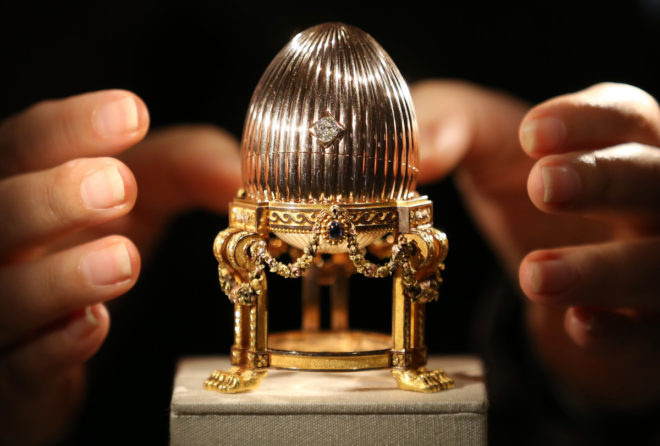
Summer of 2021 has allowed me to stop and reflect, and offered me breathing space to relax. In that time, during an exciting excursion in New York City’s memorable historical sites and vivid colors, I laid my eyes first on a beautiful replica of a aft-spoken work of art, tucked away in the back of a family-owned party store in Park Slope, right off Grand Army Plaza.
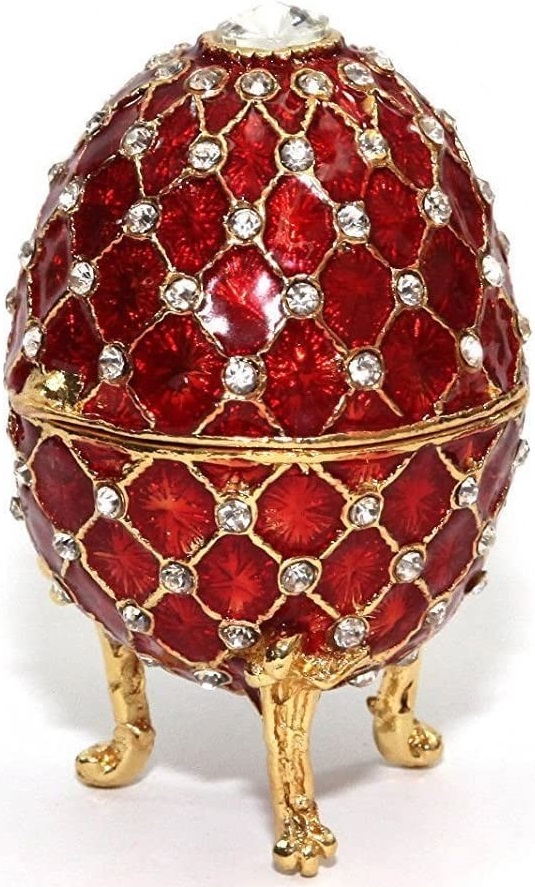
Simply: The Fabergé Egg.
I was compelled to buy the small bobble. I needed to have a piece – even if an imitation – of a history lined with beauty and grief, with me in a brief act of consumerism, arrogance and vanity not unlike the Russian social stratosphere who enjoyed the Egg’s presence. I love stopping to admire the false Egg on my shelf, knowing it was found at a random moment of an incredible and heartwarming day.
I question why I am drawn to the old, to the ancient, the lost and the histories so far away and detached from me of which I could never be a part. Maybe it is my inquisitive nature to ask questions, maybe my interests are reflective of my belief that we ought to bring the ancient past back under a microscope and understand the implications behind them. Or more generally, it is a reflection of what most of us look for when we ask complex questions: how did what we know come to be?
That leads me to the mystery of the Russian monarchy, its downfall and the material presence of the Fabergé family.
Art of the Egg
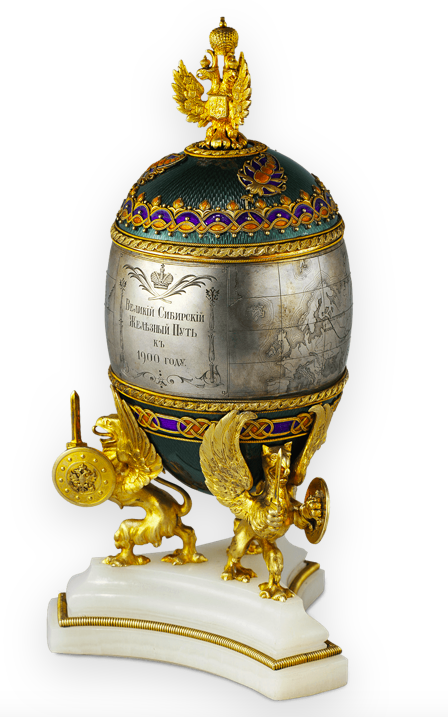
An elusive, exquisite work of art representing – at first glance – an Easter decoration designed to invoke happiness. A visible smile in exchange for over a year of painstaking work to craft each one delicately. The gold, silver, jade and diamond inlays of each egg form a completely unique design that cannot be replicated. These are the Magnum Opus of jeweler Peter Carl Fabergé, along with his father Gustav Fabergé who became premiere “artist-jewelers” for their passion in goldsmiths and jewel production. In rising to prominence in the late 19th and early 20th century, they became official retainers to the Russian Romanov Courts, with a coat of arms and luxury granted only cemented their role as an international powerhouse of the unique. The House of Fabergé perfected intricate techniques of their craft and grew to employ some of the greatest artists, designers and jewelers to ensure their dreams remained alive and saw success.
We understand an egg as a food item, or means of aesthetic comfort: the simple round shape, the smoothness, the knowledge that what the shells hold would be delicate and therefore worth careful handling. The Fabergé family understood this appeal, and adhered to form through a variety of treasures. The eggs then celebrate the aspects of peace and pre-Revolution that the Romanov family enjoyed, documenting the love and passion of Nicholas II and Alexander III to their wives and mothers.
Looking at the collections and each of their “surprises” inside, knowing there was a key history in their formation, knowing there are very few left extant in this world gives me pause to appreciate the raw effort put into art. Jewelers, painters, architects and so much more, the people who create are people who shape the history of humanity, and affect the mindset of those around them. I am no creator, but an admirer of the lost, the ancient, and the adored ghosts of the past. The Eggs are precisely a reflection of the past, held in the hands of the powerful ghosts of the Russian courts. In specific, of the beauty, tragedy and horror associated with these beautiful Russian bobbles. The history of these eggs, designed for the Imperial Romanov Family, is caressed with a motherly touch, given an air of mystery and splendor… and stained by the blood the the many innocents and aggressors around it.
The Fall of the Romanov Family
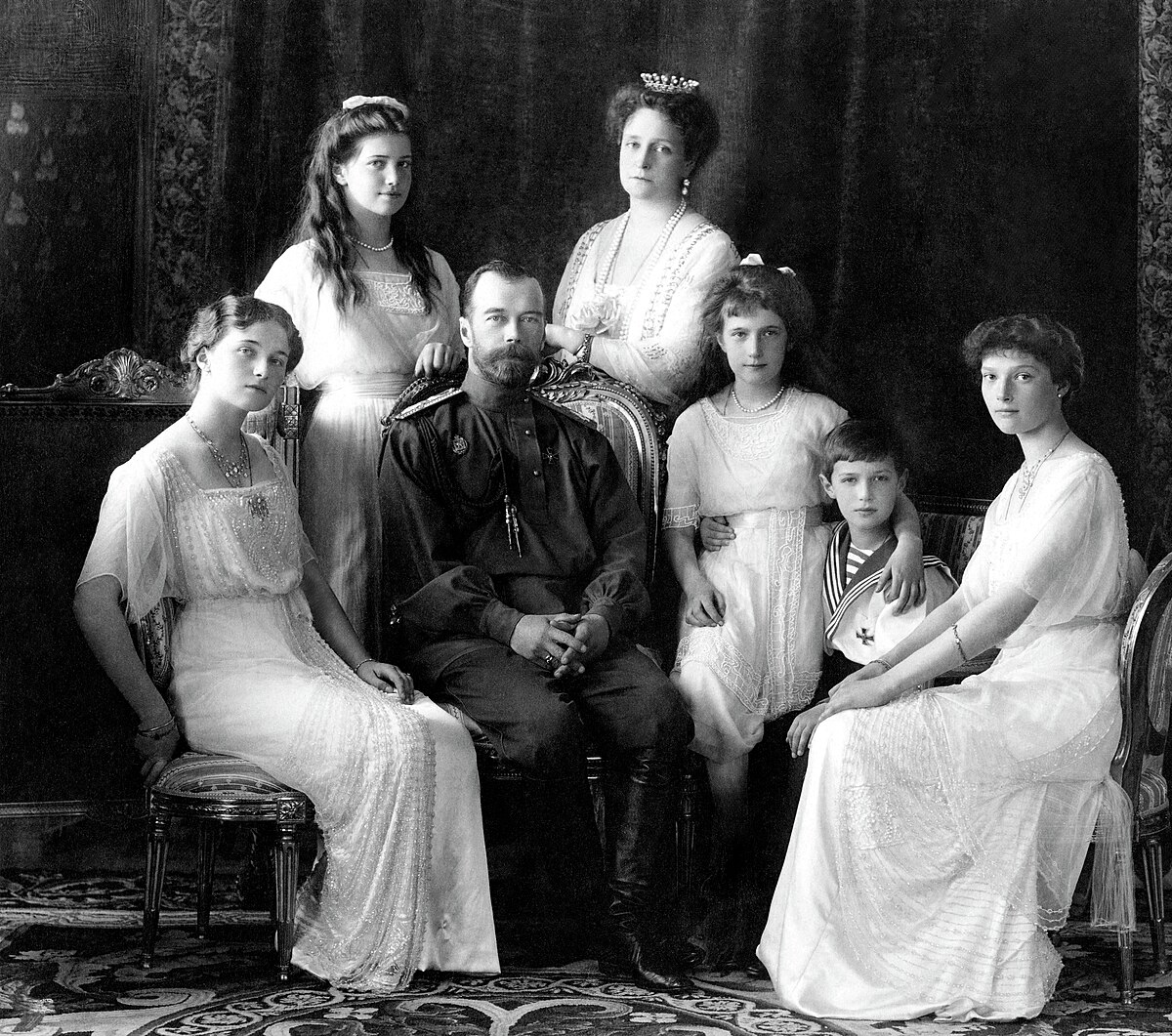
Under the final Romanov rule, Russia was rapidly modernized and phased out serfdom in 1861, leaving the lower class in severe poverty. Members of the nobility had become civil servants, few became businessmen and mercantilism began replacing the men and women of decadence and those who ruled with authority. The divide between the fabulously wealthy and desperately poor began to affect the morale of the commoners and their outlook toward the Romanov dynasty, made especially apparent with the ever-flashing bourgeoisie culture in Russia. With the inflation of decadence, the market demand for decorate arts and imperial gifts skyrocketed.
The cost of indulgence was high, as ownership luxury and decorative art had been used to establish dominance over the economy and the people with a bedazzled, iron fist. With the public and international interpretation of Russia known in the early 20th century as people displaying lavish bobbles of nationalism, crop production suffered and the mass public starved. Looking toward their Tsar, their leader, the proletariat could only see constant glitz and glamor being commissioned on a daily basis under Tsar Nicholas II, who used decorative, expensive art as a display of power. It isn’t a surprise then that the people interpreted Tsar Nicholas II as an ineffective leader who must be replaced by one more suitable to handling public concerns.
With Nicholas II’s documented inefficacy and lack of interest in holding total power as a Tsar, the dazzling pieces and frames dotting his palace offered an introspective of the man himself: his love for his family and interest in fine arts stood above all else. Sweet as this may be, it does not make for an effective leader who is expected to put aside personal ambition for the fate of Russia and her people.
However, the handling of Russia’s economy and people leading to his abdication and execution were not the first time Nicholas II was considered a ruthless and uncaring leader to his people. Consider the Bloody Sunday massacre of 1905 which led to the beginning of the 1905 Revolution. Rather than managing dissidents and engaging in dialogue with violent protestors, Nicholas II sanctioned public killings of unarmed people by the police while he remained safe far outside St. Petersburg. This started his descent into being surrounded by rebels, keeping only those he liked in positions of power to maintain his strength. Excessive decadence was a key, if only moderate, part in his downfall, being overthrown by dictators who promised equitable sharing of the massive Imperial wealth among the commoners.
With the fated execution of the entire Romanov family, the question of “why” still burns. Outside of lavish decadence, it is hunger and pain, the sensations people fight to avoid daily, that caused the February and October Revolutions that began Nicholas II downfall. As World War I raged, the Tsar diverted grain and food almost wholly to front-line soldiers, procuring more resources than what could be created on a weekly basis. While Nicholas II abdicated the throne and felt the country could be better managed than by his hand, he did was unaware that the Bolsheviks sought to completely erase traces of monarchy, fighting in favor of control. Without a monarchy, totalitarianism set in. Nicholas II abandoned his throne for nothing, and Bolshevism slowly rose following his death.
All the while, he was surrounded by his precious bobbles and Fabergé Eggs as they became involved in both his death and the Bolshevik uprising that later became the Soviet Party. Ignoring the plight of the people, abandoning any sense of peaceful reform sealed his fate as the final Monarch of Russia.
Eggs as Capital: Stalinist Intervention
Following the execution of the Romanovs, each political and personal ally of Tsar Nicholas II were hunted to solidify one thing: there would be no more kings and queens and no longer allowed were survivors, advocates and supporters of the Romanovs. Down with the monarchy, down with decadence, so it was said. The Bolsheviks of 1918 later attacked the House of Fabergé and subsumed into the newest Bolshevism ideology, associating political establishments with a notion of rigidity, discipline, centralization and brutal adherence to social overturns and revolution, hoping to eliminate the economic and political stranglehold the aristocratic and elite classes once held over the masses.
With the Russian Revolution of 1917 over, Founding President Vladimir Ulyanov (Lenin) ordered the treasuries and armories of the Romanov family ransacked. Among the items confiscated were the sentimental yet worthless Fabergé eggs, which were both adorned and surrounded by gold, precious gems and silver pieces and transferred to the Kremlin, deep in the heart of Moscow. While the 1916 Order of the St. George egg was found to be missing – later discovered in the care of Dowager Empress Maria Federovna – each egg represented a unique, economically straining snapshot of the state of Russia, its Imperial family and its people during a time of famine and strife.
As Lenin’s health waned, he urged to the Soviet party in his Last Testament to negate and remove Joseph Stalin from power, arguing that Stalin would not properly utilize his newfound political and personal power as General Secretary. With this, Lenin’s words came to life when Stalin began centralizing power with a firm rule and appointing his confidants to political stations otherwise unattainable by one-party rule, but possible through maneuvering and dictatorship.
Stalin’s first years were weighed with the constant threat of economic collapse, a problem inherited from his recent successors. To curb this problem, Stalin began to trade and sell Russian antiquities, art and specifically, mementos of the Russian Imperial Families, starting with the fabled Fabergé eggs, which until 1927 had been sealed and unknowingly guarded in dark crevices of the Kremlin Armory, likely forgotten due to the Leninist reformations of the early 1920’s. To finance Stalin’s ambitions of turning Russia from a peasant society into a leading industrial and militaristic superpower, the Bolsheviks had the eggs fetched, probably from some decrepit crate in a gothic shadow of a corner, feeling the eggs would fetch a good price from Western territories looking to hoard Russian art.
The eggs at the time were severely undervalued (and most definitely overvalued today). Depressingly, Agathon Fabergé had been plucked from his Bolshevik prison to precisely appraise the eggs and jewels, before being tossed back into prison as the eggs were to difficult to sell. Note: this was before the rise of the phrase “Black Market”, and so there was not an established clandestine trade operation between peoples or countries without reference. Making communication with an untrusting hemisphere of capitalist nations ultimately made eggs for auction unfeasible, until private collectors began buying en masse.
Stalin’s quest to gain much needed Western capital resulted in the eggs sold to entrepreneur Armand Hammer, whose father spearheaded the United States Communist Party. The directive of selling Russia’s culture for foreign currency came to be known as the “Treasures into Tractors” directive, which in Russia had not been a vague concept as Lenin regularly traded furs and caviar for wheat. With 57 of the 69 known eggs found, 12 are still twisting in the wind.
The Social Outlier: Fabergé’s Winter Egg
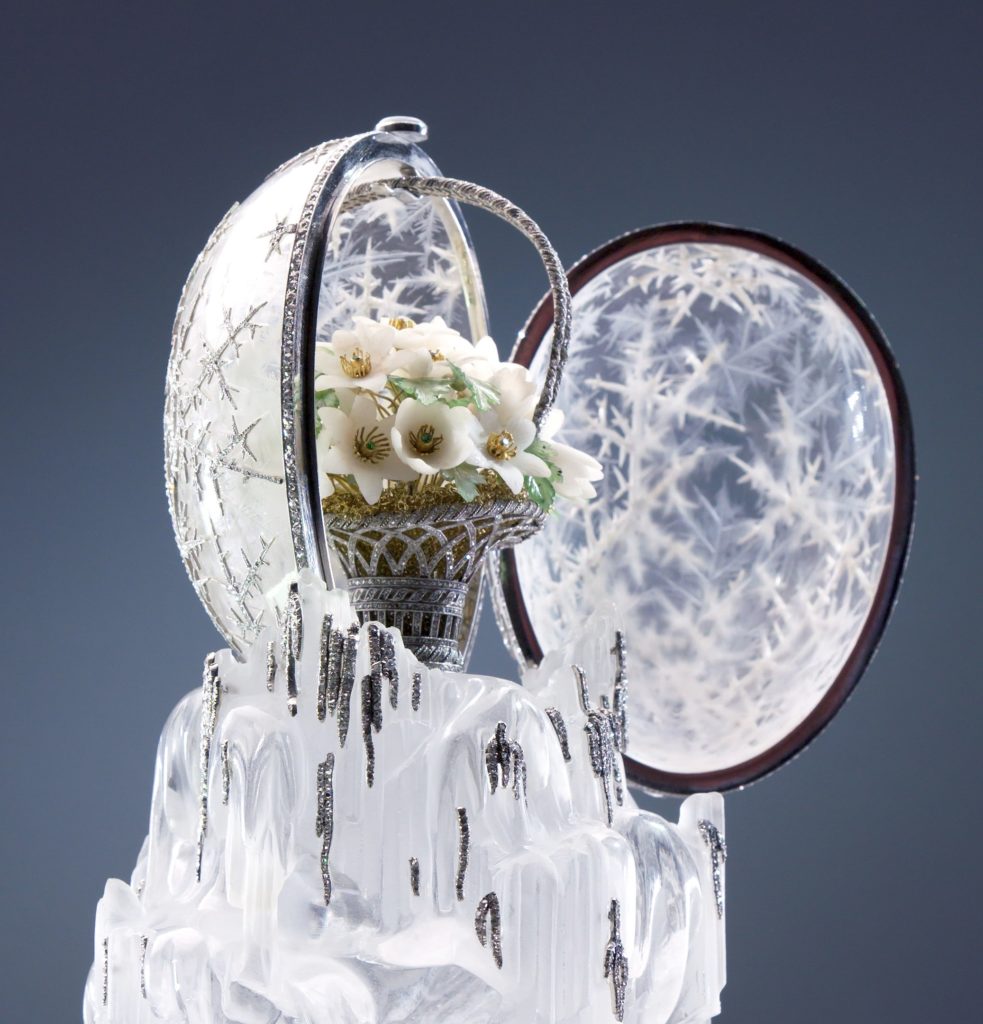
On a side note, of these 57 eggs, one caught my attention. During the final years of Nicholas II’s reign, a fabulously decorated egg – the Winter Egg of 1913 – was created. The special note regarding this egg is in its simple appearance, was designed by Almi Pihl, who was the only known female workmaster in Fabergé’s history until that point. The egg speaks of snowy, wondrous simplicity watching the flakes from the safety of a seasonal babochka cabin in the countryside. Its exterior? Made of 3000+ diamonds in the shape of snowflakes. The Winter Egg sold originally for 24,700 rubles, and the most expensive egg commissioned for the Imperial Family, sold to Sheikh Saud Al-Thani of Qatar for a heart attack-inducing $9,579,500. It stood to represent the Winter Palace, home of the Romanovs and the chief seat of power.
The elegance of the egg is met only by the unique circumstances that placed Alma at the center of its creation: the Karelian birch trees sourced for “Birch Eggs” are grown only in Finland, who were a territory of Russia until claiming its independence in 1940. As the Karelia region was handed to the Russians following the Winter War, it speaks volumes that an independence seeking Karelia, Finland, later the opposition to Russia, would have a representative – Alma Pihl – be sent to the Fabergé workshop and become a part of upholding Russian decadence. Beyond politics, religion or general belief, the birth of the Winter Egg speaks highly to Alma’s skills and perseverance to serve in a position traditionally held by men. For an oppressive regime in Russia, this fact is impressive (in my opinion).
Conclusions of the Present
How exciting it must have been to create art that is loved and coveted by most who encounter it, to be called upon by the Imperial Court as personal artists with freedom to design as you please. How terrifying it must have been to know an unknown enemy rested, strengthened their forces and pillage, loot or destroy your art because of its importance or connection to others. To know your art would put your life and your family’s lives in mortal danger.
Let’s not mistake the subject, in the end they are only bedazzled Easter eggs. Yet the Eggs’ historical roots find themselves embedded in Russian royalty, rebellion and international renown. The Fabergé Egg series are deeply tied with the extreme decadence of the Russian Romanov Court, the abject poverty looming on the outside of the palace walls, and Bolshevik’s overthrow of Tsar Nicholas II to end the consolidation of power and decadence. Sure, the Eggs ended up in the hands of and sold off , but that is a result of intertwined fates and histories tangentially related to the Soviet uprising.
Our continued fascination with centennial history of the last Romanovs is derived from a powerful, dangerous glamor of a private family battered by tragedy. The deaths of the Romanovs put away the autocratic notion of control, and this insane difference compared to American politics is striking and bizarre. This holds our attention. The Eggs being the center of an international Easter egg hunt is also nothing short of hilarious and endearing.
I am further fascinated not by the severe vanity and richness of the royals, but of the history behind the walls of every home, of every person, and every work of art. The Fabergé Egg is a symbol of these three factors, complete with an association to history on the downfall of decadence. Despite the Eggs and their millions net worth; wealth, like aristocracies fade and crumble against the memory and action of man. If nothing else, I am glad art can be preserved despite its negative outlook and associations.
As an end note, I was lucky to see a series of true Fabergé Eggs at the Metropolitan Museum of Art, on loan and courtesy of the Matilda Geddings Gray Collection. Since the exhibit is set to end in November, it hit the top of my bucket list and made for a beautifully noisy, hilarious and colorful weekend:

Sometimes, it is the simpler things in life that keep us afloat. For me, it is the souvenirs I collect on my adventures and travels that I can view everyday with impunity, as I ask what more adventures are there to be had. The world is a vast place, its entirety unknowable. Yet these small items of antiquity bring a smile and contemplation. Always.
Sincerely,
N